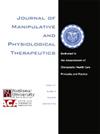Effects of Cervical Mobilization on Balance and Proprioception in Patients With Nonspecific Neck Pain
IF 1.4
4区 医学
Q4 HEALTH CARE SCIENCES & SERVICES
Journal of Manipulative and Physiological Therapeutics
Pub Date : 2024-07-01
DOI:10.1016/j.jmpt.2024.09.011
引用次数: 0
Abstract
Objective
This study investigates the effect of cervical mobilization on balance and cervical proprioception in patients with nonspecific neck pain.
Methods
A prospective, double-blind, randomized clinical trial was conducted involving a 3-week treatment protocol for which 66 patients were randomly assigned to 2 groups. Both groups underwent conventional physiotherapy (hot pack and transcutaneous electrical nerve stimulation) twice a week for 3 weeks along with additional cervical mobilization in the mobilization group, and sham mobilization in the sham control group. Static and dynamic balance, cervical proprioception, cervical mobility, and pain intensity were evaluated using a Kinesthetic Skill Training System 3000 device, the “Joint Position Error Test,” Cervical Range-of-Motion Instrument, and the visual analog scale, respectively.
Results
After treatment, significant improvements were noted in dynamic balance, mobility, pain intensity (P < .001, P < .001, P < .001, respectively), and proprioception in the left direction of rotation in the mobilization group (P = .003) that were significantly greater than those observed in the sham mobilization group (P < .001, P < .001, P < .001, P = .003, respectively). Although a significant decrease was observed in the deficits of static balance (P = .044) and proprioception in the right direction of rotation (P = .011) after mobilization, the changes were similar in both the mobilization and sham mobilization groups (P = .192, P = .154, respectively).
Conclusion
Cervical mobilization led to significant improvements in dynamic balance, pain intensity, mobility, and partial improvements to proprioception in a comparison with a sham mobilization group, while the effect on static balance was not significant.
颈椎活动对非特异性颈痛患者平衡和运动感觉的影响
目的本研究探讨了颈椎活动对非特异性颈痛患者的平衡和颈椎本体感觉的影响:本研究采用前瞻性、双盲、随机临床试验的方法,将 66 名患者随机分为两组,每组接受为期 3 周的治疗。两组患者均接受常规理疗(热敷和经皮神经电刺激),每周两次,持续 3 周,同时动员组患者还需进行颈部动员,而假对照组患者则需进行假动员。分别使用运动技能训练系统 3000 设备、"关节位置误差测试"、颈椎活动范围测试仪和视觉模拟量表对静态和动态平衡、颈椎本体感觉、颈椎活动度和疼痛强度进行评估:治疗后,动员组在动态平衡、活动度、疼痛强度(分别为P < .001、P < .001、P < .001)和左旋转方向本体感觉(P = .003)方面均有明显改善,且明显高于假动员组(分别为P < .001、P < .001、P < .001、P = .003)。虽然动员后观察到静态平衡(P = .044)和右旋方向本体感觉(P = .011)的缺陷明显减少,但动员组和假动员组的变化相似(分别为P = .192、P = .154):结论:与假性动员组相比,颈椎动员可显著改善动态平衡、疼痛强度、活动度和本体感觉的部分改善,而对静态平衡的影响并不显著。
本文章由计算机程序翻译,如有差异,请以英文原文为准。
求助全文
约1分钟内获得全文
求助全文
来源期刊
CiteScore
3.00
自引率
7.70%
发文量
63
审稿时长
29 weeks
期刊介绍:
The Journal of Manipulative and Physiological Therapeutics (JMPT) is an international and interdisciplinary journal dedicated to the advancement of conservative health care principles and practices. The JMPT is the premier biomedical publication in the chiropractic profession and publishes peer reviewed, research articles and the Journal''s editorial board includes leading researchers from around the world.
The Journal publishes original primary research and review articles of the highest quality in relevant topic areas. The JMPT addresses practitioners and researchers needs by adding to their clinical and basic science knowledge and by informing them about relevant issues that influence health care practices.

 求助内容:
求助内容: 应助结果提醒方式:
应助结果提醒方式:


